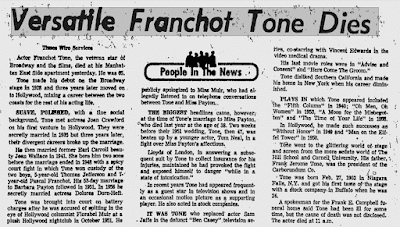First of all, I must share that I was so pleasantly surprised by the size of Franchot’s role in Moulin Rouge! Because of my mental connection to the modern Nicole Kidman film, I assumed this movie might be a full-out musical and that assumption indicated to me that Franchot would play a wealthy, handsome suitor waiting to woo the leading lady from the sidelines in very brief scenes. I should really stop making suppositions about what a movie will be like and just watch it! After seeing it, I can tell you that Moulin Rouge is a delightful romantic comedy (with some musical numbers) and Franchot has a large starring role opposite Constance Bennett (in dual roles).




Douglas Hall (Franchot Tone) is a musical theater composer who refuses to put his wife Helen (Constance Bennett) in a show. Helen, a former singer in a musical sister act, has a background in theater. Doug has certain notions about how a housewife should behave. Doug is so convinced that a wife should be at home and not on the stage that he makes sure no other producers in town hire Helen either. It must be said that although it may sound like Franchot’s character is controlling and unsympathetic, his character actually comes across as quite caring and loving in the film. Douglas Hall’s relationship to his wife early in the film reminds me of the dynamic between Ricky and Lucy Ricardo on I Love Lucy. Unlike Lucy, Helen decides to leave Doug after one too many interferences.


When she realizes that Raquel, the other half of her former sister act, has won the starring role in Doug's production, Helen concocts a plan. Helen and Raquel are not biologically sisters, but were able to play sisters because of their extreme likeness. Helen will secretly take Raquel's place during rehearsals and prove her talent once and for all.
Here's where you have to suspend reality a bit. In a Parent Trap-type switch, Helen dyes her hair blonde and changes her clothes and
voila! Everyone mistakes her for the exotic Raquel. Including her husband. (Personal note: I really hope my husband would still recognize me if I dyed my hair blonde and adopted an affected accent. I'm pretty sure he would.) The newly separated Doug is instantly attracted to Raquel as is his pal and colleague Victor (Tullio Carminati).
The rest of the film revolves around Helen's performance as Raquel. As Raquel, she falls in love again with her estranged husband, but is also hurt that Doug can so quickly be attracted to someone new. Like Franchot, Constance Bennett is an actress who is often overlooked and underrated, in my opinion. Even though the premise is a little far-fetched, Constance is truly great as both Helen and Raquel. The love scenes between Franchot and Constance are quite romantic and the film ends happily and sweetly.






I've documented on this blog that Franchot, in his later years, was largely disparaging of his roles in romantic comedies. Franchot was a fine dramatic actor and certainly deserved more substantial film roles, but I feel that he discredited his romantic comedies a bit too much. Franchot certainly had a flair for comedy and his romantic scenes are some of the most passionate of the 30s and early 40s. I could watch Between Two Women, His Butler's Sister, Three Loves Has Nancy, and this particular film over and over. Sure, they are light and breezy romances, but the stories are endearing and the players are so adept that they make it all look effortless.
In my opinion, Franchot masterfully tackled all genres of film. He was, unfortunately, typecast early on, marked as "Mr. Joan Crawford", and struggled to gain award-worthy parts of which he was more than capable. But his talent still shines through in all of his films. Sure, there were some less-than-stellar films thrown his way (especially in the 1940s), but I can name a handful of stinkers that each of his contemporaries starred in during that time as well. It was pretty typical of the studio system of that era. For every picture you truly wanted to make, the studio bosses and their iron-clad contracts strong-armed you into making two or more pictures of which you wanted no part.
If you enjoy romantic comedies that involve humorous mix-ups, passionate moments, and musical numbers (think Busby Berkeley), then you will enjoy watching Franchot Tone and Constance Bennett in Moulin Rouge.































































